Local level Brexit vulnerabilities in Scotland: Brexit Vulnerabilities Index (BVI)
This research identifies areas of Scotland that are expected to be most vulnerable to the consequences of Brexit, and what drives those risks to support local authorities and other organisations in understanding local risks around EU exit.
4. Mapping Vulnerabilities across Scotland
This chapter provides a detailed description of the interactive mapping tool that is available at https://bit.ly/30W1UVQ. This tool shows local results for each datazone in Scotland, and for each local authority area.
The interactive map is designed to support local authorities' and other organisations in understanding local risks around EU exit and to complement their wider knowledge and analysis. Whilst results are provided for individual datazones, these should not be viewed in isolation. The risks that an individual datazone faces will depend on a range of wider factors such as the vulnerability of the wider region in which is it located, commuter patterns and unique local characteristics.
The Interactive Brexit Vulnerability Index Map
As described in the previous Chapter, the Brexit Vulnerability Index Score is an additive index combining all eight factors listed in Table 2[24]. The Brexit Vulnerability Index Map visualises vulnerability to Brexit in different areas. The first map that appears when clicking on the link is the Scotland overall map. Areas most at risk from Brexit appear in darker green and areas that are relatively less vulnerable are shaded in dark purple. The colour shades represent deciles. In other words, the 1st decile illustrates those areas that are amongst the 10% most vulnerable datazones, the 10th decile the 10% least vulnerable ones. Every decile therefore captures around 700 datazones.
Figure 8 Screenshot of BVI Tool
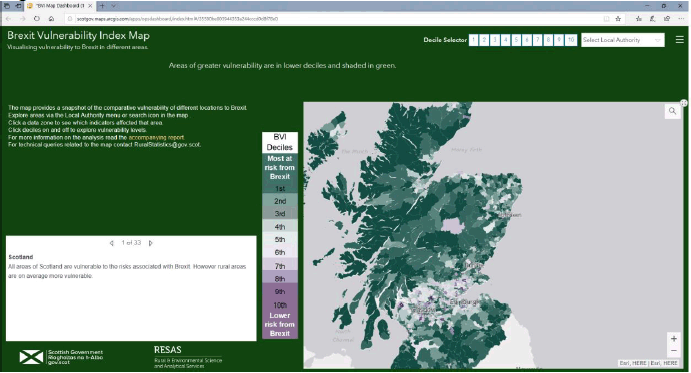
On the top right of the website, deciles can be selected. The user can for example select decile 1 and decile 2 and only datazones within these deciles are highlighted in the map.
Figure 9 BVI decile selector Tool
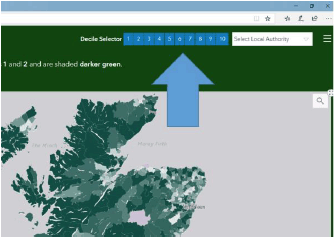
Right next to the decile selector, the user can select a local authority. The tool then zooms into the selected local authority and all datazones within the local authority become clearer. On the left side of the website a window appears providing explanation for the selected local authority.
Figure 10 BVI local authority selector Tool
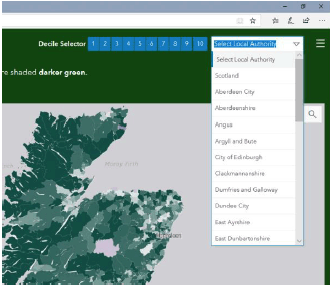
If a user clicks on a specific datazone, a graph appears summarising a simplified version of the data underlining the overall BVI. The top 8 bars show what decile the datazone is located, in terms of each of the variables included in the BVI. If for example a datazone appears in decile 1 for the variable "Income Deprivation" this means that it belongs to the 10% most household income deprived datazones in Scotland. If it appears in decile 10, this means that overall income is highest in this datazone. (Note that for European funding variables, decile 1 will be receiving the highest payments, and decile 10 the lowest payments.) Annex 2 explains how the BVI is calculated and it should be noted that the deciles do not simply add up to the overall BVI.
Figure 11 BVI datazone selector Tool
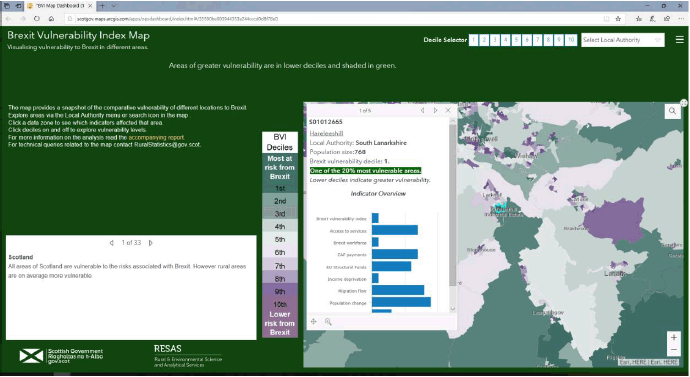
Lastly, the mapping tool has a search function. The user can click on the magnifying glass in the top right corner of the map and type in a postcode or a street address. The map then zooms into the datazone the point of interest is located in and the user can click on the datazone to get additional information.
Figure 12 BVI postcode search tool
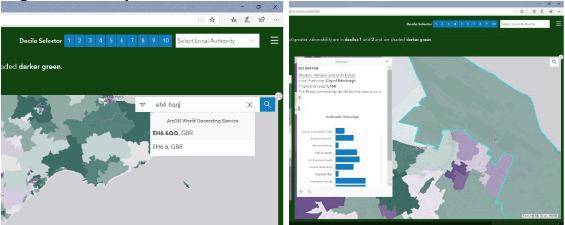
A spreadsheet including both the data underlying the mapping tool, but also additional data that can be used to recalculate the BVI score is published alongside this report.[25] This allows users to also readjust the weights applied. Annex 2 explains how the BVI was calculated using ranked data.
Contact
Email: ruralstatistics@gov.scot
There is a problem
Thanks for your feedback